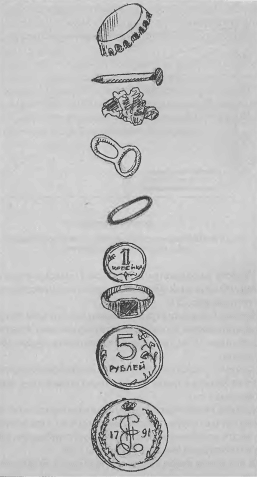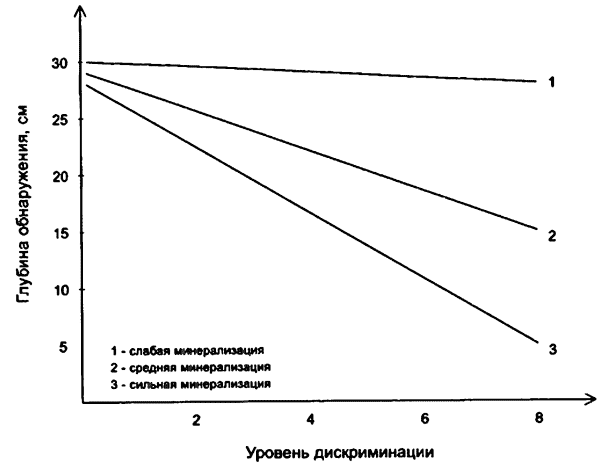The maximum efficiency of the detectors based on the principle induction balance, significantly depends on their exact configuration. Wrong tuned device will not detect deep or small objects (under deep see objects the size of a coin at a depth of 30 cm). Moreover, the powerful the device, the greater the value for it is set up. Less powerful devices react to wrong settings, to a lesser extent. Detailed instructions for configuring specific devices listed in the accompanying manuals. Here are only General comments on this topic, concerning any metal detectors.
Typically, the setup includes the following steps:
- thresholding;
- ground balancing;
- sensitivity adjustment;
- setting the discrimination level.
Threshold setting
Adjustment of the threshold, or the minimum background sound still audible by the operator, is the first and important stage in the instrument settings. Some modern dynamic threshold detectors is configured only in static mode search All metal, whereas in the mode Discrimination unit operates without threshold background (silent search). However, for most efficient operation and in this mode it is important to establish the necessary threshold in the mode "All metals". For the correct threshold settings the coil is kept at a distance of 70-90 cm from the ground and metal objects and use the handle to configure the threshold set barely I hear a constant background sound that, in fact, is called the threshold. This background should be kept to a minimum and maintained at this level during the the total time of operation of the device.
Deep or shallow objects don't provide a clear signal, however, due to the change the threshold that the human ear can easily distinguish, you will already know what's under the coil is some sort of metal object. This is the need for proper threshold settings. If it gets louder or disappear, for example, due to temperature fluctuations or poor pound, some devices (Imperial 300, TM 808) special button, you can instantly return it's original value. Sometimes you have to resort to the button constantly. Therefore, for convenience we developed a special scheme that allows to carry out automatic adjustment of the threshold. Such a function is called - locked loop. In some devices, you must first configure the threshold manually and then use the switch "auto" set threshold is maintained automatically at a predetermined level in the process of working with device.
Self-tuning is an important component of modern metal detectors dynamic action. In low-cost models of metal detectors usually is constant the average level threshold, which is not always convenient when work in the mode "All metals" due to the constant background sound.
Correct setting of the threshold is important for manual ground balance.
Ground balancing
The detuning from the pound required to achieve the maximum depth of the action of the device, especially in conditions of strong mineralization of the pound. Most modern metal detectors this operation is performed automatically and continuously as salinity changes. Thus, the following information has attitude to devices that have a handle for manual ground balance.
The ultimate goal of the ground balance is the same threshold when raised and lowered the coil. The first and important stage of ground balance is the choice of the plot of ground free of metal and minerals such as the magnetite. The choice of the site must be carried out in the mode "All metals" the middle position of the handle of the detuning. Used two types of handles - single-turn at a scale of 1 to 10 and desyatiblochnoe. First we need to install the handle in the first case in position 5, the second will be done in 5 turns the opposite direction training hindered rotation. (Actually this pen can rotate in any direction indefinitely, passing 10 times through a zone friction, which can be considered the initial point of reference).
There are two methods of ground balancing. First, the so-called static method after each adjustment knobs of the detuning from the pound level threshold background Another set manually, the dynamic method provides for the automatic setting of the threshold in the process of detuning. Consider how is the detuning from the pound in either case.
When using the static method raise the coil over the pound to a height of 35-40 cm Press and release the button (or spring-loaded switch) the adjustment threshold, then lower the coil to a distance of about 2 cm from the pound and note the threshold, which can increase or decrease. If the volume of the background increased, turn the knob of the detuning from the pound one the division or one turn in the direction of reducing the volume. Again lift coil and press and release the button of adjustment of the threshold. If lowering coil volume threshold of the background has been reduced, turn the knob the detuning from the pound in the opposite direction at half the division or a half rotation in the opposite direction. Then lift the coil and adjust the threshold. Repeating this procedure several times until you get to the volume threshold of the background would be the same when lowered and raised the coil.
To use the dynamic method, the detector must have the automatic setting of the threshold. The process of ground balancing in this case is that on one hand you raise and lower the coil, while the other hand to rotate the handle ground balance until such time as the threshold will not be the same when raised and lowered the coil. Compared to the static this method is more convenient, however not all devices have this opportunity.
These procedures greatly increase the efficiency of the detector, although, unfortunately, it should be noted that a perfect 100% ground balancing possible only theoretically. The presence in the pound conductive minerals leads to the appearance of secondary signals that mask the primary signal from the object, reducing thus the depth of the device. However, by adjusting the sensitivity you can increase the efficiency of the detector.
Sensitivity adjustment
Modern metal detectors have a high sensitivity. So, the coin (on the air) they feel at a distance of 30-40 cm, However, detect that same coin in the pound at this depth the device can only under the condition that the coin have lain in it long enough, oxidized oxides and spread around it in the form of a halo, as if increasing the size of the coin.
It is known that the depth of detection of an object in the pound is directly proportional to the square this object facing the coil. When the area is large, and secondary the signal generated by the object, is quite strong. The smaller the object and what he deeper, the weaker the signal. For example, the device will respond to the samovar, buried to a depth of 1 m, however, neither the metal detector will not detect at this depth the coin. The fact is that even if done correctly offset from the ground there are additional secondary signals from the minerals surrounding the coin that the device must be separated from the main signal from object. If we set pen sensitivity for maximum, this will also increase and harmful signals from the minerals of the soil. Therefore, in highly mineralized soils, the device will work better with more low sensitivity because the weaker signals from the object are to be heard more clearly. Thus, start with the maximum level the sensitivity, but then reduce it to a reasonable level if the ground is highly minerals.
Setting the discrimination level
Under discrimination understand this mode of operation of the detector, wherein the response of the device to unwanted objects missing. Changing the level discrimination, you can ignore these or other unwanted objects or groups of such objects.
In Fig. 22 presents the number of items in ascending order of their electrical conductivity. Objects of small size that are related to the category of garbage have a lower conductivity and are relatively easy to build up, increasing the level of discrimination. Objects with high conductivity (or having large size) do not allow them to build up and will be perceived the device, even at the maximum level of discrimination. It should be borne in mind that, after it was rebuilt from reeds cans, we will lose a thin gold rings and other small valuable objects, and a very thin gold chains cannot be detected most metal detectors even at shallow depths.

Fig. 22. A number of items in ascending order of their conductivity
The discrimination level has a great influence on the depth of detection of objects when working on mineralized soils (Fig. 23).

Fig.23. The influence of salinity of the soil and the level of discrimination in depth object detection
Curve 1 (good soil) shows that even when the discrimination level 10, silver coin can be detected up to a depth of 28 cm, with most of garbage device ignores.
Curve 2 refers to moderately mineralizovannoi pound. The same coin in this the pound can only be found at a depth of 15 cm.
Curve 3 characterizes the strongly mineralized pound. In this case, the loss the maximum depth. When setting the discrimination level above 5 major a silver coin can only be found at a depth of 5 cm
In recent devices capable of selective discrimination, when ignored separate unwanted objects or groups of objects with low electrical conductivity (nails, foil, etc.), and high (pull tabs from cans). Some detectors allow you to adjust the width of the window ignoring within wide limits.
It follows that, when running on a heavily mineralized soils you must use a minimum of discrimination. In this case, of course, have dig up more findings related to the category of garbage. At the initial stage development of the instrument it is recommended not to use discrimination and to dig everything.
Author: L. V. Bulgak






